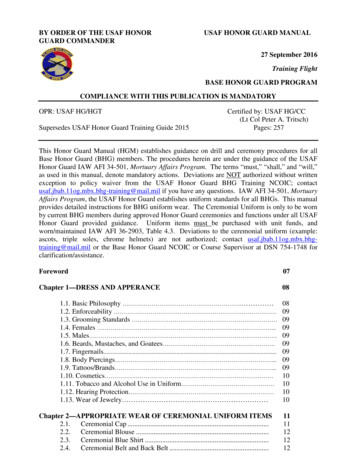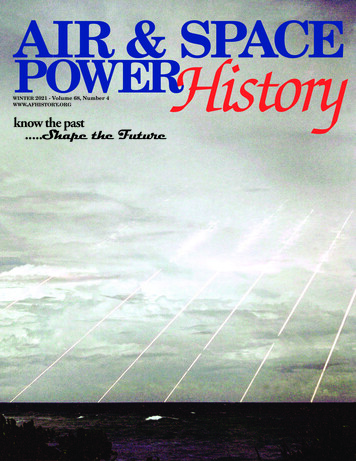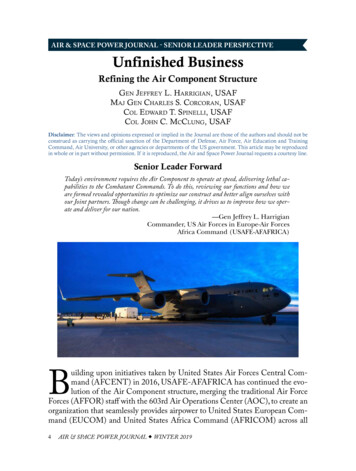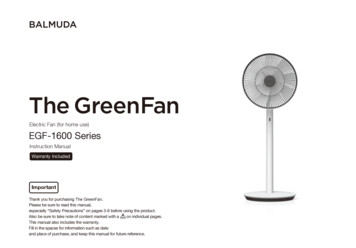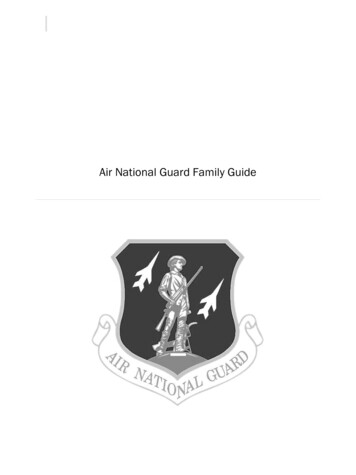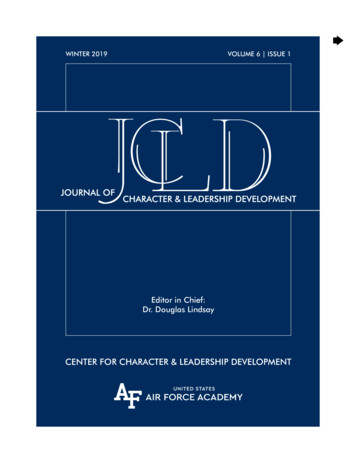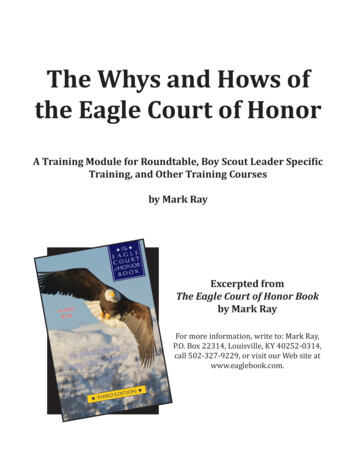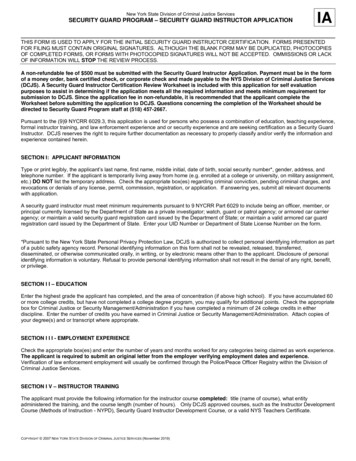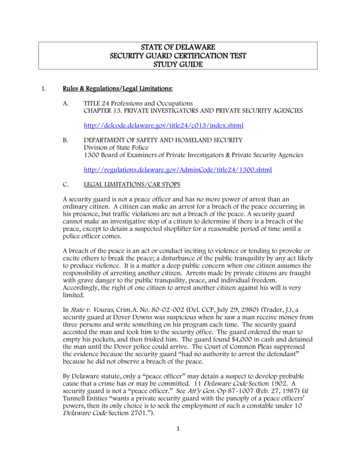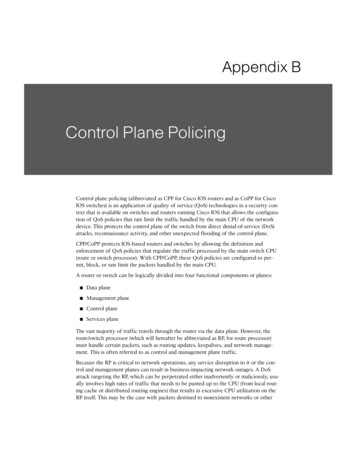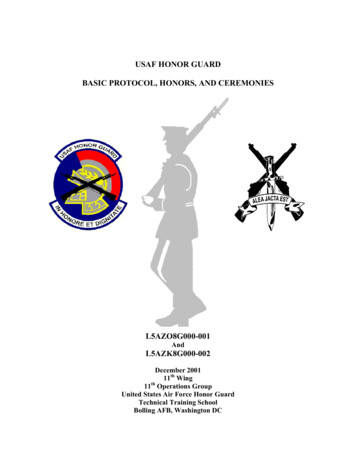
Transcription
USAF HONOR GUARDBASIC PROTOCOL, HONORS, AND CEREMONIESL5AZO8G000-001AndL5AZK8G000-002December 200111th Wingth11 Operations GroupUnited States Air Force Honor GuardTechnical Training SchoolBolling AFB, Washington DC
ForewordThis book includes information about ceremonies performed by the United States AirForce Honor Guard and Base Honor Guards worldwide. It will be used to standardizeceremonies and the manner in which they are performed from base to base. It provides detailedinstructions on key areas such as manuals, uniforms, history and traditions, and a variety ofceremonies.The “ceremonial guardsmen” is an individual of good reputation having integrity, ethicalconduct and exhibiting standards which merit respect; responsible for protecting and overseeingthe maintenance of standards on and off duty. It is truly an occupation which requiresoutstanding devotion and commitment to duty. In keeping with traditions and maintainingexceptionally high standards the honor guard will continue to remain an icon of excellence.Although this book contains information on many different types of ceremonies andissues related to them, it may be necessary for supplements to be added in the future. Anyquestions regarding those supplements may be addressed by calling DSN 754-6210.WILLIAM GREENE, III, CMSgt, USAFUSAF Honor Guard Manager2
Chapter 1—Basic Standing ManualsIntroductionPosition of AttentionPositions of RestFacing MovementsFormation of FlightPresent/Order ArmsForward March/Flight HaltTo Align Flight in LineOpen RanksMark TimeRight/Left .Chapter 2—Appropriate wear of Ceremonial Uniform ItemsCeremonial HatCeremonial CoatCeremonial BeltCeremonial Trousers/SlacksCeremonial ShoesCeremonial GlovesAll Weather CoatOvercoatGray ScarfCombat BootsSummer Dress UniformLightweight Blue JacketRain Cap .2.12.2.13.Chapter 3—ColorsGeneral InformationDefinition of TermsGeneral Rules for ions of StaffWeapons MovementsFull Honors FuneralMemorial ServiceColors SequencePersonal ColorsPosting Colors in Stands SequenceRippling to Shoulder from Port ArmsRippling to Port Arms from .11.3.12.3.13.3.14.3.15.3
Chapter 4—Firing PartyGeneral InformationEquipmentBasic Firing Party MovementsFiring SequenceLoading the WeaponUnloading the WeaponFull Honors FuneralStandard Honors Funeral4.1.4.2.4.3.4.4.4.5.4.6.4.7.4.8.Chapter 5—PallbearersFull Honors FuneralStandard Honors FuneralSix - Person Flag FoldTwo - Person FuneralTwo – Person Flag FoldCremate Sequence for SHF and FHF5.1.5.2.5.3.5.4.5.5.5.6.Chapter 6—Air Force BuglerGeneral InformationPositionsGraveside ServiceMemorial ServiceFull Honors FuneralStandard/Modified Honors FuneralVeteran Honors Funeral6.1.6.2.6.3.6.4.6.5.6.6.6.7.Chapter 7— Funeral SequencesFull Honors FuneralStandard Honors FuneralVeteran Honors Funeral7.1.7.2.7.3.Chapter 8—Retreat CeremonyPersonnelEquipmentSupport MaterialsPreparationSequence of Events8.1.8.2.8.3.8.4.8.5.Chapter 9—Air Force CordonFormation and Advancement of CordonDressing SequenceArrivalDepartureMarch OffCordon Sizes9.1.9.2.9.3.9.4.9.5.9.6.4
Chapter 10—Saber and Sword Manuals and CordonsGeneral InformationStanding Manual of Arms10.1.10.2.Chapter 11—Maintenance of the M1 ral Information11.1.11.2.11.3.11.4.11.5.Chapter 12—POW/MIA Hat Table CeremonyPersonnelEquipmentSupport MaterialsPreparationSequence of EventsExample Script/Table of Honor12.1.12.2.12.3.12.4.12.5.12.6Chapter 13—Advanced Weapon Handling TechniquesBeginning a TeamSafety and PreparationTermsTipsBasic Drill MovementsIntermediate Drill MovementsAdvanced Drill .7.13.8.Chapter 14—History and TraditionsFlag HistoryChanges in the FlagFlags on GravesFlags Covering CasketsFlag Position (Open Casket)Folding the FlagDisposing of the FlagHalf Staff/MastFuneralsDetails within a FuneralTapsSalutesUniformsMedals and DecorationsThe Pledge of 14.9.14.10.14.11.14.12.14.13.14.14.14.15.5
Base Honor Guard Creed14.16.Chapter 15---OIC/NCOIC Responsibilities on FHF/SHFGeneral InformationPre-CeremonyArrival of CeremonyCeremony (FHF/SHF)615.1.15.2.15.315.4
Chapter 1STANDING MANUALS (without a weapon)1.1. Introduction.1.1.1. This chapter explains the basic movements which must be mastered before attempting toaccomplish drill and ceremonies with a weapon. Many of the drill movements resemble thosecovered in AFM 36-2203, Drill and Ceremonies, and others are unique to the Honor Guard.1.2. Position of Attention.1.2.1. The command is Attention. To come to attention, bring the feet together smartly, theheels and balls of feet are together and on line. Keep the legs straight without stiffening orlocking the knees. The body is erect with hips level, chest lifted, and shoulders square and even.Arms hang straight down along side the body and wrists are not bent. Place thumbs, which areresting along the first joint of the forefinger, along the seams of the trousers. Hands are cuppedwith palms facing the leg. Head is erect, neck is vertical with the body, and eyes are facingforward with the line of sight parallel to the ground. The weight of the body rests equally on theheels and balls of both feet, and silence and immobility are required. (Figure 1.1.)1.3. Positions of Rest.1.3.1. Parade Rest.1.3.1.1. The command is Parade, REST. Upon the command of execution REST, lift the leftfoot smartly and move it to the left six to eight inches apart and parallel with each other. Feetpoint straight forward, legs are straight but not stiff, and the heels and toes are touching.1.3.1.2. As the left foot moves, arms extend to the back with hands flared properly, right handover left hand with middle finger resting over middle finger, right hand inside of the left handwith fingers extended and joined, thumbs touching. (Figure 1.2.)1.3.2. At Ease.1.3.2.1. The command is AT EASE. Relax, keep the right foot in place.1.3.2.2. The position in the formation does not change, silence is maintained.1.3.3. Rest.1.3.3.1. The command is REST. Relax, keep the right foot in place.1.3.3.2. You may talk in low conversational tones. The position in the formation does notchange.7
1.3.4. Fall out.1.3.4.1. The command is FALL OUT. From the position of attention, execute a two count aboutface, step off with the left foot, and leave the formation. Unless told otherwise, remain in theimmediate area.1.4. Facing Movements.1.4.1. Two-Count About Face:1.4.1.1. The command for the movement is About, FACE. This is a two-count movementexecuted from the position of attention. Upon the command of execution FACE, lift the rightfoot just enough to clear the ground and place it perpendicular to the left foot forming abackwards "T" with both feet, arms remained pinned to the side, head follows the lead foot. Thisis the first count of the movement. The position of the left foot is not changed. Most of theweight of the body is resting on the ball of the right foot. (Figure 1.3.) On the second count, pivot180 degrees to the right on the ball of the right foot while lifting the left foot just enough to clearthe ground to meet the right, resuming the position of attention. Keep arms pinned to the side forthe entire movement. (Figure 1.4.)1.4.2. Three-Count About Face:1.4.2.1. There is no command for this movement. This movement is only performed whilemoving as a solitary member and from the position of attention. Lift the left foot just enough toclear the ground and place it in front (perpendicular) of the right foot forming a "T" with bothfeet, bend the knees slightly. This is the first count of the movement. The position of the leftfoot is not changed on the second count, lift the right foot just high enough to clear the groundand pivot 180 degrees, bringing the heels together to form a ninety degree angle (an "L"), thenbring the left foot smartly to the right foot, resuming the position of attention. Keep the armspinned at the side for the entire movement.1.4.3. Left (Right) Face:1.4.3.1. The command for the movement is Left (Right), FACE. This is a two-countmovement. To complete count one of the movement, from the position of attention, lift the left(right) foot and place it down ninety degrees to the right (left) foot forming an "L". The heel ofthe left (right) foot should be against the heel of the right (left) foot. Head follows the lead foot.The rest of the body remains at the position of attention. (Figure 1.5.) To complete count two ofthe movement, distribute the weight of the body to the left (right) foot. Lift the right (left) footand, with snap, bring it along side the left (right) foot and turn the body 90 degrees to the left(right) simultaneously. The rest of the body remains at the position of attention. (Figure 1.6.)1.5. Formation of the Flight.1.5.1. The purpose of the movement is to form a flight in line formation.8
1.5.2. The command for the movement is FALL IN.1.5.3. Upon the command: The guide moves to a position so that the formation is three pacesaway and centered on the Flight Commander (to do this he or she must take the size of theformation into consideration). Once in position the guide executes an automatic dress right dresswithout turning his or her head. The first element leader falls into a position to the left of theguide so that his or her right shoulder is touching the fingertips of the guide and executes anautomatic dress right dress. The second and third element leaders fall into a position behind thefirst element leader establishing a 40-inch distance.1.5.4. Each succeeding member of the formation falls into a position to the left of the elementleaders, executing an automatic dress right dress, establishing dress and cover. It's theresponsibility of the first element to establish the interval. Once in position, they return to theposition of attention. It's important to square off the back of the formation. When there is anodd number, fill the formation in from the third element forward.1.6. Present Arms/Order Arms.1.6.1. The command is Present, ARMS. Upon the command of execution ARMS, from theposition of attention, raise the right hand up the centerline of the body, uncupping the hand andextending the fingers and thumb at approximately waist level. Continue to raise the right handuntil the upper arm is parallel with the ground and slightly forward of the body (or to the extentof the belt, so that the blouse does not ride up). The line between the middle finger and elbowshould be straight (do not bend your wrist or cup your hand) and the palm is slightly tiltedtoward the face. Touch the middle finger to the right front corner of the brim of the hat, the outerright point of the eyebrow, or the right outer point on the eyeglasses, depending on what is worn.Thumb and fingers are extended and joined. (Do not tuck thumb.) (Figure 1.7.)1.6.2. To return to the position of attention, the command is Order, ARMS. Upon thecommand of execution ARMS, simply retrace your steps backward from present arms recuppingyour hand at approximately waist level. During present arms, silence and immobility arerequired. When performing this movement with a formation using a rifle, present arms and orderarms are completed as three count movements. (i.e. If you are NFP calling Present Arms.)1.7. Forward March.1.7.1. The command is Forward, MARCH. Upon the command of execution MARCH, stepoff with the left foot sliding your heel for the first step. Pick up coordinated arm swing, sixinches to the front and three inches to the rear. March with 24-inch steps as measured betweenthe heels. When marching, place one foot in front of the other, in a straight line versus toespointing inward or outward. To aid in maintaining cadence, the individual marching theformation can call cadence. The cadence commands are Hut, Two, Three, Four and are calledin sets of two. Hut is given on the left foot, two on the right foot, three on the left foot, and fouron the right foot.9
1.7.2. To halt, the command is Flight, HALT. Flight is called on the left foot and HALT onthe subsequent foot. Upon the command of execution HALT, take one more step with the rightfoot and close with the left.NOTE: Forward March can be given in incremental steps by using the command PacesForward, MARCH. Upon the command of execution MARCH, step off with the left foot andmarch forward the number of step commanded. On the last step simply bring the feet togetherand resume the position of attention. This movement is executed when there is not enough roomto successfully execute a Flight Halt.1.8. To Align the Flight in Line.1.8.1. The purpose of this movement is to align the flight in line formation much like thecommand COVER does in column formation.1.8.2. The command for this movement is Dress Right (Left), DRESS. Upon the command ofexecution everyone except the first rank turns their head 45 degrees to the right (left) lookingdown line to align themselves to the right (left) making sure that they are directly behind theperson in front of them. Simultaneously, everyone except the last rank, will lift their left arm upand parallel to the ground, fingers extended and joined, palm facing down. The rest of the bodyremains at the position of attention. To adjust yourself within the formation, take short choppysteps. The first element must maintain fingertip to shoulder contact. Silence is maintained. Atthe completion of this movement each element should be aligned from the right or left flank ofthe formation.1.8.3. To return to the position of attention the command is Ready, FRONT. Upon thecommand of execution FRONT, bring the head back to the front and the arm down to the sidewithout slapping the side of the leg.1.8.4. This movement can also be executed at close interval. The commands are At CloseInterval, Dress Right (Left), DRESS.1.8.5. To execute the movement, everything is the same except: the left hand slides up to the hipwith the palm resting on the hip, fingers extended and joined pointing down. The elbow is bentand flared out 45 degrees. The first rank acquires elbow to arm contact.1.9. Open Ranks.1.9.1. The purpose of this movement is to open up the formation for inspection.1.9.2. The command for this movement is Open Ranks, March. Upon the command ofexecution, the first element takes two paces forward, halts, and performs an automatic dressright, dress. The second element takes one pace forward, halts, and performs an automatic dressright, dress. The third element remains in place and executes an automatic dress right, dress. Atthe completion of this movement, each element should be aligned from the right flank of theformation.10
1.9.3. Alignment procedures are used to ensure each file is properly aligned.1.9.3.1. Once the formation has been given the appropriate dressing command, the FlightCommander moves by the most direct route, to the end of the first element. From this position,the front rank is aligned. If necessary, individuals are instructed to adjust their placement byname or number. The Flight Commander takes short side steps to verify alignment. He/she thenfaces to the left, marches forward, halts on the end of each succeeding rank, executes right face,and aligns the rank.1.9.3.2. After verifying the alignment of the last rank, the Flight Commander executes a face inmarching to the right and marches three paces from the front rank, halts and executes a left face.The command Ready, FRONT is given. The Flight Commander takes one step forward andexecutes a right face.1.9.4. Once alignment is complete, the Flight Commander gives the command Ready, FRONT.This movement is accomplished by simply returning to the position of attention by bringing theleft arm down sharply down to the side simultaneously snapping the head back to the front.1.9.5. Once the inspection sequence is complete the flight is ready to be closed. This is donewith the command Close Ranks, MARCH. Upon the command of execution the first elementstands fast, the second element takes one step forward and halts and the third element takes twosteps forward and halts. This all happens simultaneously with each element halting at theposition of attention.1.10. Mark Time.1.10.1.The purpose of this movement is to march in place.1.10.2. The command for this movement is Mark Time, MARCH. Upon the command ofexecution lift the left leg and begin marching in place, lifting each foot four inches off theground. Keep the arms suspended at your side. The rest of the body remains at the position ofattention. From a march, the command is Mark Time, MARCH. Upon the command ofexecution, take one more 24-inch step and then mark time ensuring you suspend your arms toyour side.1.10.3. To halt, the command is Flight or Honor Guard, HALT. Upon the command ofexecution, take one more step, then bring the feet together and halt at the position of attention.1.10.4. To pick up a march, the command is Forward, MARCH. At which time one more stepat mark time is taken then step out with a 24-inch step and coordinated arm swing.1.11. Right/Left Flank.1.11.1. The purpose of this movement is to turn a formation 90 degrees to the right (left),changing the attitude of the formation.11
1.11.2. The command for this movement is Right (Left) Flank, MARCH.1.11.3. Upon the command of execution, take one more step, suspend your arms to your side,pivot on the ball of the left (right) foot 90 degrees to the right (left), and step off with a 24-inchstep and coordinated arm swing.12
Figure 1.1. (Attention)Figure 1.3. (2 Count About Face)Count 1Figure 1.4 (2 Count About Face)Count 213
Figure 1.5. (Left Face)Count 1Figure 1.6. (Left Face)Count 2Figure 1.7. (Present Arms)14
Chapter 2APPROPRIATE WEAR OFCEREMONIAL UNIFORM ITEMS2.1. Ceremonial Hat.2.1.1. The silver braid on the ceremonial hat rests on the top of the black visor portion of the hat.Pull the two tabs outward to tighten the braid. Place a few small drops of super-glue behind thetabs and set them into place until they dry. This prevents the silver braid from becoming looseand moving out of place2.1.2. Secure the black patent leather chinstrap into the up position:2.1.2.1. Unscrew the two chrome hat buttons holding the chinstrap into position.2.1.2.2. Reverse the chinstrap so that the strap buckle is to the right of center when viewed fromthe rear.2.1.2.3. Screw the chrome hat buttons into place ensuring the wings are in the up position.2.1.3. The black patent leather chinstrap is worn when inclement weather dictates it. Usually,very strong winds or driving rain storms make it necessary to wear the chinstrap down. Thechinstrap is designed for these reasons and is used accordingly.2.1.4. Color teams and personal colors bearers wear the black patent leather chinstrap down.Wearing the chinstrap down prevents the flag(s) from knocking the ceremonial hat from thehead. Additionally, drill teams and flight line cordons may find it necessary to wear thechinstrap down due to continuous drill movements or adverse conditions.2.2. Ceremonial Coat.2.2.1. Iron the lapels of the blouse down to enable all three buttons of the blouse to be displayed.Always iron with an ironing cloth. This prevents ironing marks, burns, shining, etc.2.2.2. The aiguilette fits snugly along the shoulder seam of the blouse. Use several large babypins to secure the aiguilette from underneath the blouse. The tassel is pulled down and thespiraled cord is sewn or glued to the inside of the larger portion of the auguilette.2.3. Ceremonial Belt.2.3.1. The ceremonial belt is worn when it is practical and pertinent to the ceremony. Wear theceremonial belt where the member does not do an extreme amount of moving (i.e., marching inparades). Awards bearers, flower bearers, OIC, NCOIC, color teams, personal colors bearer etc.,wear the ceremonial belt. Pallbearers and Firing Party do not wear the ceremonial belt.15
2.3.2. When blousing a guardsman, a minimum of two people are used.2.3.2.1. Adjust the ceremonial belt to fit very tightly around the waist. The ceremonial belt restsbetween the second and third button of your uniform.2.3.2.2. The "blousee" holds the belt in the approximate position where the belt fastens withsome slack being provided for the "blousers" hands.2.3.2.3. The "blouser" positions the hands along two side seems on the back of the blouse,raincoat, or overcoat.2.3.2.4. The "blouser" pulls the excess material from the front of the uniform and folds itunderneath the two side seams in a forward position. When bloused, the entire uniform appearsneat, wrinkle-free, and without bunches.2.3.2.5. The "blousee" then fastens the belt in front.2.3.2.6. The "blouser" re-checks the ceremonial belt and places the two keepers one thumbslength from the chrome belt buckle on both sides of the buckle.2.4. Ceremonial Trousers/Slacks.2.4.1. Use an ironing cloth when ironing.2.4.2. When sitting down in ceremonial trousers/slacks, roll the excess material located underthe knees into a neat fold to prevent wrinkling.2.5. Ceremonial Shoes.2.5.1. Clean and shine the shoes. Furniture polish works well.2.5.2. Use edge dressing on the soles of the shoes, to include the welts.2.5.3. Tuck the bows from the shoe strings into the shoe.2.6. Ceremonial Gloves.2.6.1 Worn with the end of the glove folded under providing a neat appearance.2.7. All Weather Coat.2.7.1. The coat is wrinkle free.2.7.2. The belt loops are removed from the coat for blousing purposes.16
2.8. Over Coat.2.8.1. The coat is wrinkle free.2.8.2. The belt loops are removed from the coat for blousing purposes.2.9. Gray Scarf.2.9.1. Scarf is worn left over right.2.9.2. When the scarf is worn, wear only black gloves.2.10. Combat Boots.2.10.1. May be worn with the ceremonial uniform during heavy snowfall or extremely muddyconditions.2.10.2. Do not blouse the ceremonial trousers/slacks over or into the boot.2.11. Summer Dress Uniform2.11.1. Proper wear of the summer dress uniform is located in AFI 36-2903, table 3.2 DistinctiveUniforms.2.11.1.1. Always wear the ceremonial belt while wearing the summer uniform.2.11.2. The OIC/NCOIC of the ceremony may authorize wear of the summer dress uniformwhen the temperatures exceed 94 degrees or 90 degrees plus with relative humidity of 60% orhigher.2.11.3. The OIC/NCOIC of the ceremony should request a weather forecast from the installationor region where the ceremony will take place.2.11.3.1. The forecast should include temperature, apparent temperature (wind chill/heat index),wind velocity, humidity and precipitation probability.2.12. Light Weight Blue Jacket2.12.1. Always wear the light weight blue jacket during transit to a ceremony versus sitting inthe ceremonial blouse.2.12.2. Do not place a crease in the sleeves of the jacket.17
2.13. Rain Cap Cover2.13.1. Whenever you wear the raincoat for a ceremony, you must wear the raincap cover overthe ceremonial hat. The ceremonial hat emblem is displayed on the outside of the raincap cover.Place a small hole in the raincap cover large enough for the post of the hat emblem to fit. Thisenables you to display the hat emblem on the outside of the raincap cover during ceremonies.2.13.2. Roll the raincap cover underneath the back edges of the ceremonial hat to produce a snugfit and neat appearance.2.13.3. Always wear the rain cap cover when not performing ceremonies to prevent fading andto maintain the cap’s appearance.18
Chapter 3COLORS3.1. General Information.3.1.1. Introduction: An Air Force Color Team consists of four personnel, and if possible, ofequal height, including bearer of the National Colors (NCT), the bearer for the Air Force Flagand two rifle guards. All members will be familiar with all positions on the team.NOTE: An Air Force Color Team may consist of more than two flag bearers. In this case theflags are in order of precedence from left to right as you look at the team from the front. In theevent that the team is not equal in height, the team is arranged in a tall to short manner.3.1.2. Commands: The supplementary command of Colors, will be called for all commandswhenever performing with another element. (i.e. funerals, etc.) ex. Colors, Present, ARMS.3.2. Definition of Terms.3.2.1. Colors Turn. There are two positions in which a colors turn is executed: Standing stilland marking time. When standing still, the command Colors, Colors Turn, MARCH is givenby the NCT, the whole team takes four steps, in place, while turning 90 degrees to the right.After completing the turn on the fourth step, the entire team slides off on step five, being the nextleft foot. The Colors Turn is also done while marking time to position and halt the team for thepresentation of colors. The command Colors is given on the left foot while marking time. Theteam then takes four steps in place while rotating 90 degrees to the left. The NCT gives thecommand Halt on the left foot.3.2.2. Left About. The command is Left About, MARCH. The left about is a sixteen-countwheel movement . The left about is done shoulder to shoulder turning to the left in a wheelingmanner on the NCT's command. The color team rotates 180 degrees, in a half-circle pivoting onthe central point of the team. After the turn is completed the colors are given Forward, Marchor Halt. This command is called on the left foot.3.2.3. Right/Left Wheel. The command is Right/Left Wheel, MARCH. The color team isshoulder to shoulder while marching or marking time. They wheel around 90 degrees to the rightor left with the pivot point being the central point of the color team. This movement will becompleted in eight steps.3.2.4. MARK TIME. The command is given while marching and is used to suspend progresstemporarily. If colors are marching in a single file, Mark, TIME is given as consecutive (boththe left and right) heels strike the ground, i.e. Mark on the left and TIME on the right. Executethe movement on the very next step (left foot).3.2.5. Dress Center, Dress. This command is given to dress the colors or align them evenly. Onthe command, each member of the team lowers their head in a three-count movement. The NCT19
decides if anyone moves forward, backward, or sideways. All members of the team dress on theNCT. When the team is aligned properly, the NCT commands Ready, FRONT, the membersraise their heads in a three-count movement to the original position.3.2.6. Stand Fast. This is a term used by the colors to remain in a certain position while otherunits are performing another movement.3.2.7. Colors, Stand At, EASE. This two-count movement is executed when the colors are atthe order position. On the command of execution, the rifle guards move the left foot six to eightinches to the left. (Figure 3.1) On the second count the rifle guards twist the wrist of their righthand counterclockwise. At the same time the right hand is centered on the body. The left hand isbrought straight across the body to grasp the weapon above the right hand in a fist. The firstcount for the flag bearers is the same as mentioned above for the rifle guards. The flag bearerskeep their right hand in position along the seam of the trousers. On the second count grasp thecup of the sling with the left hand. The hand should be in a fist, fingers tightly together. (Figure3.2)3.2.8. Dip. Dipping the flag is accomplished by fully extending the right arm to a horizontalposition while at the shoulder position. The wrist is locked and curled in order to secure the flag.The movement is accomplished with a silent three count when rendering honors.3.2.9. Ready Cut Sequence. At the position of Right Shoulder, the ready cut movement is usedto return the flag bearers left hand to the position of attention. The command is Colors, Ready,CUT. On the command of execution the flag bearer sharply returns the left hand to the positionof attention. At the position of order, the color team executes a two count movement. On thefirst count, the team sharply brings their left hand to their side, parallel to the ground. On thesecond count, the team cuts their hand straight down to their side.3.3. General Rules for Colors.3.3.1. Never dip the American flag.3.3.2. All commands echoed by the NCT are performed on the Commander of Troops (COT)command of execution. Example: If the command Present, ARMS is given by the COT, theNCT echos the command Present and the movement will be executed on the command ARMS.3.3.3. All commands given or echoed by the NCT while marching are given and executed on theleft foot, except Right Shoulder, ARMS.3.3.4. Chin Straps Down. Color bearers and rifle guards always wear their rear chin strapsdown. This is done to avoid the flag being caught momentarily around the hat which may causeit to fall off.3.4. Implementation.20
3.4.1. Formation. The color team is formed in a single rank from the right to left with the rightrifle guard in position first, followed by National Colors, Air Force Colors, and the left rifleguard. The bearer of National Colors (NCT) gives or echoes all commands for the color team.3.4.2. Receiving, Posting and Retiring the Colors. The colors are presented during each fullhonors funeral, arrival/departure of a distinguished visitor and retirement ceremonies. Colors areposted and retired during ceremonies honoring a person or occasion3.4.2.1. The colors are never carried cased during a military funeral.3.5. Responsibilities.3.5.1. Right and Left Rifle Guards. The primary responsibility of the right and left rifle guardsis to protect the National and Air Force Colors. The rifle guards keep unauthorized personnelfrom walking between the colors and other elements. They also assist in the alignment of thecolors during windy days, while marching.3.5.2. Bearer of National Colors. The bearer of the National Colors is also the NCO
USAF HONOR GUARD BASIC PROTOCOL, HONORS, AND CEREMONIES L5AZO8G000-001 And L5AZK8G000-002 December 2001 11th Wing 11th Operations Group United States Air Force Honor Guard
